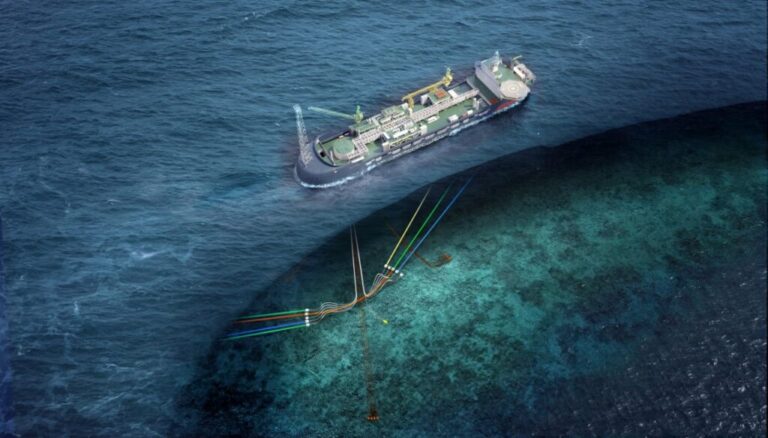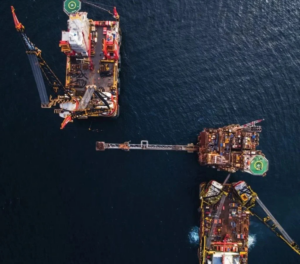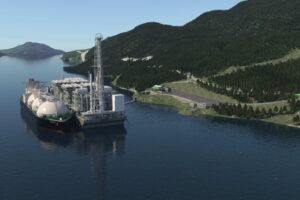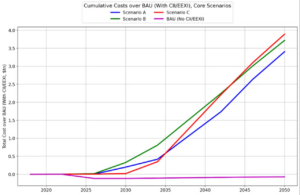Canada’s proposed oil & gas emissions cap: Boost in production, jobs, and economy or across-the-board cuts?
Canada, which is said to be the world’s fourth-largest producer of oil and the fifth-largest producer of natural gas, has come up with draft regulations to set a greenhouse gas (GHG) pollution cap for the oil and gas industry. The government claims the latest regulatory tool in the raft of measures that are part of its wider climate plan will limit pollution, drive innovation, and create jobs. However, those opposed to the proposed regulation argue the move will result in cutbacks across the board instead of any gains.

Key highlights:
- Canada is upping its decarbonization game with oil & gas GHG pollution cap
- Cap on GHG pollution equivalent to 35% below 2019 levels by 2030
- Cap-and-trade system to prompt cleaner energy production
- Greater emphasis on decarbonization puts different spins on oil & gas future
- New energy world order and oil & gas sector’s place in it
- Decarbonization: a work in progress
- Different timelines for large and small operators
- Canada goes in hot pursuit of low-emission future
- Cap’s emission cuts averting multi-billion climate change damages
- Oil & gas production, jobs, and GDP to take a hit
- Opposition in focus: British Columbia, Alberta, Saskatchewan, and Newfoundland and Labrador
- Cap might not be within constitutional competency of federal government
- Loopholes threaten to derail clean investment and emission cuts
The road to net zero greenhouse gas emissions is paved with challenges for all industries and sectors, but none seem as affected by the energy transition implications as the fossil fuels arena. As a result, navigating the emerging new normal buffeted by tectonic shifts in energy and regulatory policies, economic challenges, geopolitical tensions, supply constraints, and growing energy demand will require closer collaboration bonds across all energy sectors, along with support from governments.
Canada recently boosted its energy transition journey with the Cleantech investment tax credit (ITC) tools to spur greater investments in wind energy, solar power, and energy storage industries. The country still intends to pursue carbon capture, utilization, and storage (CCUS) and CCS, but it is unclear what kind of impact the strengthening of greenwashing laws will have on these low-carbon pursuits.
Meanwhile, the proposed regulations to put a clear limit on greenhouse gas pollution from oil and gas production are said to be designed around what is technically achievable within the sector while allowing continued production growth. These regulations are expected to work by setting a cap on greenhouse gas pollution within the sector, equivalent to 35% below 2019 levels, creating a cap-and-trade system designed to recognize better-performing companies and incentivize those that are higher polluting to invest in making their production processes cleaner.
Where do oil and gas stand in this new energy world order?
Navigating the fast-evolving energy landscape interspersed with sustainability and climate-related reporting pitfalls will be a tall order and a nearly Sisyphean task for Canadian producers and developers, unless clear guidelines and regulations are in place. Once ambiguity has been removed, Canada’s businesses will be able to speed up their sustainability journey to hit climate and decarbonization milestones in time to reach net zero aspirations.
In the meantime, companies need to tackle greenwashing and greenhushing risks to set the ball rolling on the build-out of green trust and avoid litigation along with scenarios that would lead to monetary penalties of up to $10 million and even $15 million for subsequent orders, or three times the benefit derived from the misrepresentation, failing that these fines can go up to 3% of the corporation’s annual global gross revenues.
The best advice, given by a law firm, to avoid this worst-case scenario stated: “Businesses must immediately take stock of their existing and future public claims and representations about the sustainability and impact of their practices, products and plans with respect to climate change and other environmental matters. This should involve careful review of how representations are developed, framed, qualified and substantiated.”
Related Article
To shed more light on the new greenwashing provisions of the Competition Act, the Competition Bureau launched a public consultation in July 2024, intending to inform the development of enforcement guidance about environmental claims, including those related to the new provisions. The new provisions about greenwashing, added to the law following a series of amendments that took place on June 20, require businesses to have testing or substantiation to support certain environmental claims.
The Bureau also released a new edition of the ‘Deceptive Marketing Practices Digest‘ that addresses environmental claims to provide a foundation to understand the issues around environmental claims in general and how businesses can comply with the provisions of the Competition Act already in place before the amendments. The Canadian Net-Zero Emissions Accountability Act establishes the country’s legal commitment to achieving a low-carbon economy by 2050.
The regulation requires the government to set emission reduction targets and develop plans perceived to be credible and science-based to achieve each target. Since the oil and gas sector is seen not only as a major contributor to Canada’s economy but also as its largest source of greenhouse gas emissions, it is perceived to have a critical role to play in meeting the country’s climate objectives, like every sector working to cut pollution.
Such undertakings are anticipated to be boosted by capping the greenhouse gas pollution from the oil and gas sector, which is one of the key measures outlined in Canada’s 2030 Emissions Reduction Plan, a sector-by-sector roadmap to reduce the country’s overall emissions to 40–45% below the 2005 pollution levels in the most cost-effective way possible while building a stronger economy.
In a bid to allow the oil and gas GHG pollution cap to account for current activity levels, the proposed regulations would use data reported by operators in 2026 to set the first oil and gas GHG pollution cap level. The cap for the first compliance period 2030-2032 would be set at 27% below emissions reported for 2026, which is estimated to be equivalent to 35% below 2019 emissions.
This would regulate upstream oil and gas facilities, such as offshore and liquefied natural gas (LNG) production facilities, which are deemed to represent the majority of emissions from the oil and gas sector, with the upstream subsector covering 85% of emissions in 2022.
Related Article
-
‘Pivotal’ move for Canada’s first LNG export facility to come online
Business Developments & Projects
A recent analysis from the International Energy Agency (IEA) shows that global demand for fossil fuels, including oil, will peak by 2030 without any more policy action to reduce emissions. With further policy action, oil demand would peak even sooner.
If the demand for oil and gas peaks in the coming decade and begins to decline, the fuels extracted with the least amount of pollution are anticipated to be in the highest demand. Therefore, the Canadian government believes the oil and gas greenhouse gas pollution cap will help the sector remain competitive, as the global economy continues to decarbonize, allowing Canada to respond to shifting global demand.
Related Article
Related Article
The government is adamant that the oil and gas greenhouse gas pollution cap, which is part of a suite of measures to cut pollution, including significant financial support for carbon capture and storage and other clean technologies that also support workers, such as through the federal Canada Growth Fund and new investment tax credits, will help ensure the oil and gas sector does its fair share to reduce GHG pollution while creating new jobs.
In December 2023, Environment and Climate Change Canada published a ‘Regulatory Framework for an Oil and Gas Sector Greenhouse Gas Emissions Cap,’ which confirmed the government’s intent to implement the oil and gas GHG pollution cap through a new cap-and-trade system, and proposed various design features, including subsectors covered by the emissions cap, the level of the emissions cap, and rules about flexible compliance options.
The feedback received on the regulatory framework was used to develop the oil and gas GHG pollution cap proposed at the start of November 2024, according to Canada’s government, which claims that this puts a limit on GHG pollution, not oil and gas production.
At a time when oil and gas companies are reaching record profits, the oil and gas GHG pollution cap is envisioned to stimulate the kinds of investment needed to innovate and build “a strong, thriving economy that works for everyone,” according to Environment and Climate Change Canada, which is seeking public feedback on the proposed ‘Oil and Gas Sector Greenhouse Gas Emissions Cap Regulations.’
Based on Statistics Canada’s latest figures, operating profits in the oil and gas sector increased tenfold after the pandemic, rising from $6.6 billion in 2019 to $66.6 billion in 2022, and have remained strong with consecutive record years. As capital expenditures have been targeting new production rather than decarbonization, the Canadian government’s draft regulation is anticipated to encourage the sector to redirect these record profits into decarbonization.
Related Article
The Canadian Climate Institute estimates that by 2025, the country will experience annual losses in economic growth of $25 billion because of climate change, underlining the need to take urgent action, especially as the most recent ‘National Inventory Report’ states that Canada’s oil and gas sector accounted for 31% of national emissions in 2022, making it the largest contributor to the country’s GHG emissions footprint.
Decarbonization: a work in progress
Early estimates from the Canadian Climate Institute show that Canada’s emissions started to decline in 2023, the first year since the pandemic when the economy was back in full operation. Environment and Climate Change Canada analysis underscores that oil and gas production is projected to grow 16% by 2030–2032 from 2019 levels, provided the sector implements technically achievable decarbonization measures as part of the oil and gas GHG pollution cap.
Gudie Hutchings, Minister of Rural Economic Development and Minister responsible for the Atlantic Canada Opportunities Agency, outlined: “Newfoundlanders and Labradorians are proud of our energy sector and our workers, and we agree that we need to cut pollution to stay competitive in the global economy. The offshore industry in Newfoundland and Labrador has found innovative ways of producing the energy the world needs while creating less pollution. That is a win-win.”
The proposed regulation, which would establish a national cap-and-trade system that would apply to upstream oil and gas activities, encompassing onshore and offshore oil and gas production, oil sands production and upgrading, natural gas production and processing, and the production of LNG, is anticipated to address a wide range of environmental issues and freely allocate emissions allowances to facilities covered by the system.
At the end of each year, each facility will need to remit to the government one allowance for each tonne of carbon pollution it has emitted, enabling the government to give out fewer allowances over time, corresponding to the declining emissions cap. As part of this initiative, operators are expected to have an ongoing incentive to reduce their emissions and will be able to buy allowances from other operators that have invested in pollution reduction, if they do not have enough allowances to cover their emissions.
The government elaborates that operators can also contribute to a decarbonization program or use GHG offset credits to cover a small portion of their emissions – up to 10% of the decarbonization program and up to 20% for offsets with a maximum of 20% for both options. Canada believes that the decarbonization program would fund projects that support the reduction of emissions from the sector.
Related Article
-
Canadian government invests $22 million in EverWind’s green fuels hub
Business Developments & Projects
Jonathan Wilkinson, Minister of Energy and Natural Resources, remarked: “A cap on pollution from the oil and gas sector is a critical part of our thoughtful plan to fight climate change and build a strong economy. As the world moves toward a low-carbon future, the cap will ensure the long-term economic competitiveness of a sector that employs hundreds of thousands of Canadians and drives significant wealth by ensuring Canada will supply products that offer a low-carbon footprint.
“Countries around the world are moving actively, including Canada’s democratic allies and other major countries, including China. We can choose to stick our heads in the sand and get left behind, or we can choose to act. Today, we are acting.”
Different timelines for large and small operators
With the use of 2026 as a baseline for reporting data, the oil and gas GHG pollution cap would be based on real-world conditions, underscored the government while pointing out that the final oil and gas GHG pollution cap level would be published before the end of 2027. The proposed cap allocates allowances to operators using specified distribution rates for each type of activity.
These allowances are to be distributed before the beginning of each year, starting in 2029 for 2030, as the first compliance year. The system would be phased in for the first four years, from 2026 to 2029, and operators would be required to register and report their emissions and production. While large emitters will start reporting in 2027 for their 2026 emissions and production levels, the reporting for small operators will commence in 2029 for their 2028 levels.
Moreover, operators would need to submit verified annual reports of their facilities to Environment and Climate Change Canada for every calendar year. These reports, which are due on June 1 of the following year, would be used to identify which operators will be subject to the pollution cap and have remittance obligations. Annual reports would include the GHG emissions attributed to the facility and the production amount by industrial activity.
One of the undertakings, promoting green power is an underwater high-voltage direct current (HVDC) cable project between the U.S. and Canada, which is described as being designed to transform New York into a clean energy hub by supplying one million homes with electricity from renewable sources.
Related Article
-
‘Great progress’ in cable laying ops at mega $6 billion US-Canada subsea link to power Big Apple with renewables
Business Developments & Projects
Randy Boissonnault, Minister of Employment, Workforce Development and Official Languages, noted: “Canada’s oil and gas sector is a world leader in clean energy. As the world moves toward lower greenhouse gases, today’s cap on emissions—not production—is ensuring our economic engine remains competitive, innovative, and in a strong position to supply the world’s growing energy needs. This is how our government is cutting emissions, creating good paying jobs and supporting our energy workers in Alberta and across the country.”
Even though all operators would be required to register and report, only large operators producing above an annual threshold of 365,000 barrels of oil equivalent would have to remit allowances to cover their emissions. Large operators account for approximately 99% of the upstream sector’s emissions. The government would distribute emissions allowances to operators annually, before the start of each compliance year.
Allowances would be pro-rated across operators’ facilities based on historical production volumes and would not be able to be used for compliance under other carbon pricing systems, such as the federal output-based pricing system (OBPS). As there would be no limit to the number of allowances operators covered under the oil and gas GHG pollution cap could hold, allowances could be traded among them.
The federal government’s investments in the nature legacy programs, made since 2015, are described as the largest federal investments of its type in Canada’s history. While less than 1% of the country’s marine and coastal areas and less than 11% of its land were protected in 2015, it has now protected 14.6% of its marine and coastal areas and almost 14% of its land. The Canadian government invested $1.3 billion in the Nature Legacy Program in 2018 and $2.3 billion in the Enhanced Nature Legacy Program in 2021.
Related Article
-
No more oil & gas permits off Canada’s Pacific coast
Authorities & Government
Steven Guilbeault, Canada’s Minister of Environment and Climate Change, commented: “We are rolling out over 140 different measures that cut greenhouse gas pollution in the most cost-effective way possible, while helping to steer Canada toward the opportunities in a cleaner economy of the 21st century. And the plan is working. Canada remains on track to meet our 2026 goal under the Canadian Net-Zero Emissions Accountability Act. Emissions are down, while the economy is at full steam.
“The proposed cap on greenhouse gas pollution from the oil and gas sector is a prime example. It asks companies in Canada’s largest polluting sector to do their fair share to cut pollution by reinvesting record profits into projects that will strengthen our economy for the long term. The risks and costs of not acting on climate change are much higher than taking action. Together, working with all sectors and regions of the country, we can keep making progress for a healthy, brighter future for Canadians.”
The government of Canada will continue to engage in consultations to shape the final regulations, which it plans to publish next year. Written comments in response to the proposed cap can be submitted by January 8, 2025.
The oil and gas sector is described as a major contributor to Canada’s economy, generating $209 billion in gross domestic product (GDP) last year and accounting for 25% of Canada’s exports valued at $177 billion. It is also seen as a major employer across the country, directly employing 181,800 people in 2023.
Canada goes in hot pursuit of low-emission future
The proposed oil and gas GHG pollution cap is forecast to prompt the sector to invest in technically achievable decarbonization to attain significant emission reductions by 2030-2032, putting it on a pathway to carbon neutrality by 2050. Given the array of available emissions-reduction opportunities, oil and gas producers are already investing in these decarbonization venues.
Since the methane menace has been identified as a particularly potent greenhouse gas, preventing such emissions is seen as one of the lowest-cost ways to reduce GHG emissions, thus, Canada’s new regulation plans to ensure that the sector cuts methane emissions by at least 75% from 2012 levels by 2030. Another popular decarbonization tool is carbon capture, which is expected to play an increasingly important role in slashing emissions from oil and gas production.
Canada’s government believes the country to be well-placed to cement its position on the global scene in this technology since the Intergovernmental Panel on Climate Change (IPCC) and the International Energy Agency believe no credible path to carbon neutrality exists without carbon management technologies, such as carbon capture and storage. In light of this claim, research shows the deployment of such technologies needs to be accelerated, scaling up by nearly 200 times by 2050.
The Canadian government notes how the shift toward a low-carbon economy has led the country to become home to approximately one-sixth of the world’s active large-scale carbon management projects, using a range of approaches to capture carbon dioxide from point sources or directly from the atmosphere to be reused or durably stored. Many such projects are in the construction, design, and development phases across multiple sectors and regions.
Related Article
The continued development and deployment of carbon management technologies are forecast to form the basis of a multibillion-dollar carbon management sector in Canada that supports inclusive, high-value employment, significant export opportunities, and a more sustainable economy. While point-source carbon capture is described as a leading option for deep emissions reductions from the upstream oil and gas sector, public-private collaboration is considered critical to advance strategic, economic, and regionally appropriate decarbonization pathways.
Therefore, the government underlines that its oil and gas GHG pollution cap adds to a suite of policy measures designed to shift the industry toward cleaner production through carbon management systems and other technologies, including reducing methane emissions and switching to cleaner fuels. There are also regulatory measures, such as federal, provincial, and territorial carbon pricing systems for the sector, including Alberta’s TIER system, the federal output-based pricing system, federal and provincial methane regulations, and clean fuel regulations.
A wide range of financial support to back deployment and help develop the innovation ecosystem for carbon reduction technologies in Canada encompasses $319 million over seven years for RD&D to advance the commercial viability of emerging carbon management technologies and refundable CCUS investment tax credit (ITC) expected to provide $12.5 billion between 2022-2023 and 2034-2035 for eligible projects that enable permanent CO2 storage.
There is also the Canada Growth Fund, totaling $15 billion, which offers investment tools such as contracts for differences designed to address risk and accelerate private sector investment to grow a clean economy, including in the carbon management sector. Additionally, Strategic Innovation Fund, with $8 billion in funding, is expected to help companies reduce emissions and grow their business sustainably while the Canada Infrastructure Bank (CIB) invests in CCUS infrastructure projects.
Related Article
-
Govt to dish out millions to kickstart 11 carbon capture projects with potential to generate $20 bln
Carbon Capture Usage & Storage
As large-scale carbon capture projects are being built in the oil and gas arena and other sectors, the list of recent projects consists of Strathcona Resources’ $2 billion project to store up to two million tonnes of CO2 per year while creating hundreds of new jobs; Entropy’s project that will enable emissions reductions of approximately 2.8 million tonnes over 15 years and support more than 1,200 jobs for Albertans; and the North West Redwater (NWR) Sturgeon Refinery, seen as the world’s first bitumen refinery built with carbon capture.
There is also the Alberta Carbon Trunk Line (ACTL) for the transport of captured carbon from facilities for storage in oil fields, which is expected to be used by new carbon capture projects throughout the province to transport captured CO2 to final storage sites; and Linde, which disclosed an investment of more than $2 billion to build a clean hydrogen facility that will supply Dow’s Path2Zero production complex in Alberta, capturing more than 2 million tonnes of carbon dioxide emissions per year for sequestration.
Shell announced two new projects in Alberta: the Polaris carbon capture project and the Atlas carbon storage hub, which aim to reduce industrial emissions by transitioning to cleaner technology. The Polaris project will capture approximately 650,000 tonnes of carbon a year, while the Atlas project will store the captured carbon from Polaris and potentially other industrial facilities in the future. Once completed in 2028, these projects are expected to generate up to 2,000 jobs for Albertans.
Cap’s emission cuts averting multi-billion climate change damages
The proposed pollution cap regulations are estimated to result in net cumulative GHG emission reductions of 13.4 Mt above the baseline of reductions between 2025 and 2030-2032 to be achieved by existing measures. The incremental reduction is valued at almost $4 billion in avoided global climate change damages. When compared to the costs, modeling showed that the proposed regulations are estimated to have net benefits of $428 million for Canada.
This multimillion-dollar benefit does not account for a wide range of additional ones likely to be associated with the proposed regulations, including the additional economic activity and jobs associated with post-2032 investments in CCUS and other major decarbonization activities; the stimulation of innovation and new low-carbon industries, such as clean hydrogen; the economic and health benefits of reducing air pollution; and the longer-term competitiveness benefits of a decarbonized Canadian oil and gas sector as worldwide efforts continue to fight climate change.
Related Article
-
New clean economy legislation to propel Canada’s net zero by 2050 goal
Authorities & Government
The oil and gas sector directly and indirectly supports a significant workforce, especially in British Columbia, Alberta, Saskatchewan, and Newfoundland and Labrador. Modeling for the 2019 to 2030-2032 period shows that labor expenditure in the sectors covered by the proposed regulations will grow by 53%, which is only slightly below the 55 % growth in the baseline scenario.
Additionally, jobs in clean energy will continue to grow based on a ‘2023 Clean Energy Canada‘ report, which found the country will see 700,000 more energy jobs in a carbon-neutral 2050 scenario than today, with 419,000 of these jobs in Alberta, representing three jobs for every individual worker employed in its upstream energy sector as of 2022.
British Columbia plans to put in place an oil and gas emissions cap to serve as a backstop to the federal policy, thus, the goal will be to meet BC’s greenhouse gas emission reduction targets and avoid regulatory duplication and administrative burden for the oil and gas sector.
Alberta explained in its Emissions Reduction and Energy Development Plan (2023) its goal to achieve carbon neutrality by 2050, signaling it would explore options to achieve a 75-80% reduction in methane emissions from conventional oil and gas by 2030. The province, which has had a price on carbon emissions since 2007, recycles its proceeds to invest in emission cuts, such as methane emissions abatement.
While Newfoundland and Labrador’s offshore oil sector is already seen as one of the lowest-emitting in the country, the newest planned production project, Bay du Nord, was approved with the historic requirement to reach net-zero emissions by 2050. Like all other oil- and gas-producing provinces, NL implements a price on industrial carbon emissions via its provincial output-based pricing system.
Related Article
Saskatchewan has several projects aimed at capturing CO2 emissions from oil and gas production. In 2014, the Boundary Dam project became the first power station in the world to use carbon capture and storage technology. The province is also addressing methane emissions, including improving leak detection and repair practices and implementing ways to tackle gas flaring and venting.
Oil & gas production to take a hit
Meanwhile, Canada’s provinces, industry, and recent reports, which the government claims are based on a broad range of assumptions, including elements of the previously published regulatory framework or, in some cases, other assumptions made by the authors, indicate that the proposed regulations will reduce oil and gas production, as the emissions cap effectively functions as a production cap in their eyes.
While confirming that it is aware of third-party reports conducted by Conference Board of Canada, Deloitte, and S&P, the federal government reiterated its belief that the emissions cap would help decarbonize oil and gas production and increase efficiency to ensure the sector is on a path to net-zero by 2050.
Rebecca Schulz, Alberta’s Minister of Environment and Protected Areas, responded negatively to the proposed cap, referencing studies done by Deloitte and the Conference Board of Canada think-tank, which indicate significant impacts on oil and gas production, a sharp reduction of Canada’s GDP, curbed revenue for the provinces, job losses, and decreased investment.
The analysis from the Conference Board of Canada sounded the alarm over the implementation of the proposed cap, indicating a staggering drop in Canada’s GDP by up to $1 trillion between 2030 and 2040 and a loss of up to 151,000 jobs across the country by 2030. With this at the forefront, Schulz outlined the potential curtailment in oil and gas production, leading to tens of thousands being out of work, with the economic impact felt from coast to coast.
This would be especially evident in Alberta, which would be the hardest hit, with economic growth fall from an estimated 17.8% to 13.3%, employment drop, and a decline in revenues by 4.5% in 2030 compared to a scenario without the cap. This means that Alberta government revenues would be $4.5 billion lower in nominal terms in fiscal year 2030/31 while experiencing job losses in the range between 54,000 to 91,500.
Schulz wrote: “All greenhouse gas emissions have the same global impact, regardless of the sector or region in which they are produced. Instead of pursuing this unconstitutional cap, we are calling on your government to immediately halt further development and begin meaningful collaboration within established provincial regulatory regimes on oil and gas regulation and emissions reductions.
“Alberta would welcome federal investment to help the oil and gas industry – and other industries – advance and adopt technology to reduce emissions to support our goals of carbon neutrality by 2050. Alberta aspires to achieve a carbon neutral economy without compromising affordable, reliable, and secure energy for Alberta, Canada and the world. We know this relies on and requires investment to advance clean technology solutions.”
Another study, carried out by Deloitte, underlined that the federal cap would bring Alberta a 3.6% investment decrease, close to 70,000 less jobs, and a 4.5% reduction in the province’s economic output by 2040. While Ontario is estimated to lose over 15,000 jobs and $2.3 billion from its economy by 2040, Quebec would be left without more than 3,000 jobs and $0.4 billion.
In this scenario, Canada would be subjected to an economic loss equivalent to 1% of GDP, lower wages, job cuts of almost 113,000, and a 1.3% drop in government tax revenues, while the country saw economic growth of a mere 1.1% last year.
Kenneth P. Green, Senior Fellow at Fraser Institute, underlined: “The Trudeau government’s new proposed emissions cap on the oil and gas sector will impose significant harms on Canada’s economy, Canadian workers and our quality of life—and hit Alberta with a wallop.
“And yet, as a measure intended to avert harmful climate change, it’s purely performative (like many of the government’s other GHG regulations) and will generate too little emission reductions to have any meaningful impact on the climate. In a world of rational policy development, where the benefits of government regulations are supposed to exceed their costs, policymakers would never consider this proposed cap.”
While contemplating all the aspects of the proposed cap and the opposition it is facing, Osler business law firm’s Maureen Killoran, KC National Co-Chair Calgary; Sander Duncanson, Partner, Regulatory, Indigenous and Environmental, Calgary; Brad Gilmour, Partner, Regulatory, Indigenous and Environmental, Calgary; Sean Sutherland, Partner, Disputes, Calgary; and Sarah Taylor, Associate, Regulatory, Indigenous, and Environmental, Calgary, emphasized the constitutional question mark, which hangs over the proposed regulations.
Given the concerns that the proposed cap would violate section 92A of the Constitution, Killoran, Duncanson, Gilmour, Sutherland, and Taylor concluded: “Regulation of GHG emissions from the oil and gas sector in this manner is a step out by federal government that may be a step too far. There is a clear constitutional question mark as to whether Parliament has jurisdiction to regulate GHGs in this manner.”
Osler law firm, which noted the cap’s potential to curtail oil and gas investment and production, elaborates that unlike provinces, which have broad and exclusive jurisdiction under the Constitution Act to regulate matters related to the exploration and development of oil and gas resources, the jurisdiction of Parliament over these activities is “much narrower and must be firmly grounded in powers granted to it under the Constitution Act.”
Loopholes threaten to derail clean investment and emission cuts
Some have applauded the government’s move but warned about potential pitfalls down the road. While welcoming the draft regulations for the oil and gas pollution cap, the International Institute for Sustainable Development (IISD), which sees a firm cap on emissions as a way to enable certainty for industry to invest in decarbonization while ensuring the sector is on a path to net-zero by 2050, underscored that a robust emissions cap could pave the way for the continued growth of Canada’s largest source of GHG emissions to be halted.
Steven Haig, Policy Analyst at IISD, remarked: “The real power of the pollution cap is certainty. A strong cap would give the oil and gas industry confidence to invest in a net-zero future and assure the public that emissions will decline. While today’s draft regulations provide the foundation for meaningful emissions reductions in the sector, the proposed ‘decarbonization program’ loophole risks double-counting reductions and should be removed.”
Even though it expects the industrial carbon price will continue to be critical in incentivizing reduced emissions intensity in the sector, IISD is adamant that the policy alone has been insufficient to bend the sector’s overall emissions curve downward. To fix this, the industry is said to need a clear, long-term regulatory signal to invest in decarbonization and deliver on its promises to support Canada’s climate goals.
The draft regulations for the pollution cap are seen as a step in such a direction, but IISD urges the government to rid the regulation of loopholes and cheers the decision to omit the option of using international carbon offsets to comply with the pollution cap from these draft regulations.
IISD stated: “The policy should be further strengthened by removing the proposed ‘decarbonization program’ from the final regulations to prevent double-counting of emissions reductions in the sector. The final regulations must also be designed to ensure that any domestic offsets made available to the sector reflect real, additional, and verifiable emissions reductions.
“We urge the government to ensure international offsets remain excluded from the final regulations, replace the proposed decarbonization program exclusively with robust domestic offsets, and move quickly to finalize the regulations in early 2025. We look forward to seeing a robust oil and gas pollution cap implemented soon.”










